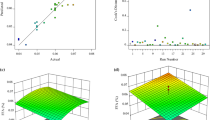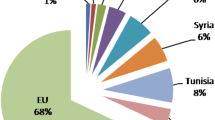Abstract
Steam distillation was applied to lampante olive oil and olive pomace oil in a laboratory-scale steam distillation equipment, and effects of process parameters (temperature, pressure and stripping steam) were determined and modeled on bound 3-MCPD and glycidyl ester formation. Levels of process parameters were optimized to minimize bound 3-MCPD and glycidyl ester formation using response surface methodology. According to the results of the study, olive pomace oil has a significant content (4.1 mg/kg) of bound 3-MCPD prior to steam distillation. Results showed that temperature of the steam distillation was highly effective on bound 3-MCPD and glycidyl ester formation. Interaction between stripping steam rate and temperature was statistically significant for glycidyl ester formation. Effects of process parameters were visualized by using perturbation plots. Perturbation plots showed that stripping steam rate was possibly effective not only on glycidyl ester formation, but also on bound 3-MCPD formation in the case of steam distillation carried out at wide-ranged process conditions. According to the optimization results, optimum steam distillation temperature is 230 °C, water flow rate is 1.2 ml/min, and pressure is 4 mbar for olive oil, and temperature is 230 °C, water flow rate is 1 ml/min, and pressure is 2 mbar for olive pomace oil to minimize the bound 3-MCPD and glycidyl ester formation.



Similar content being viewed by others
References
Shahidi F (2005) Bailey’s industrial oil and fat products, 6th edn. Wiley, Hoboken, NJ
Velísek J, Davídek J, Kubelka V et al (1980) New chlorine-containing organic compounds in protein hydrolysates. J Agric Food Chem 28:1142–1144
Zelinková Z, Svejkovská B, Velísek J, Dolezal M (2006) Fatty acid esters of 3-chloropropane-1,2-diol in edible oils. Food Addit Contam 23:1290–1298. doi:10.1080/02652030600887628
Hamlet CG, Asuncion L, Velíšek J et al (2011) Formation and occurrence of esters of 3-chloropropane-1,2-diol (3-CPD) in foods: what we know and what we assume. Eur J Lipid Sci Technol 113:279–303. doi:10.1002/ejlt.201000480
Craft BD, Nagy K, Seefelder W et al (2012) Glycidyl esters in refined palm (Elaeis guineensis) oil and related fractions. Part II: practical recommendations for effective mitigation. Food Chem 132:73–79. doi:10.1016/j.foodchem.2011.10.034
Hrncirik K, van Duijn G (2011) An initial study on the formation of 3-MCPD esters during oil refining. Eur J Lipid Sci Technol 113:374–379. doi:10.1002/ejlt.201000317
SCF (2001) Opinion of the scientific committee on food on 3-monochloropropane-1,2-diol (3-MCPD). Updating the opinion of 1994. 1:1–5. doi:10.1111/1467-8608.00251
Kuhlmann J (2011) Determination of bound 2,3-epoxy-1-propanol (glycidol) and bound monochloropropanediol (MCPD) in refined oils. Eur J Lipid Sci Technol 113:335–344. doi:10.1002/ejlt.201000313
Franke K, Strijowski U, Fleck G, Pudel F (2009) Influence of chemical refining process and oil type on bound 3-chloro-1,2-propanediol contents in palm oil and rapeseed oil. LWT Food Sci Technol 42:1751–1754. doi:10.1016/j.lwt.2009.05.021
Pudel F, Benecke P, Fehling P et al (2011) On the necessity of edible oil refining and possible sources of 3-MCPD and glycidyl esters. Eur J Lipid Sci Technol 113:368–373. doi:10.1002/ejlt.201000460
Craft BD, Nagy K (2012) Mitigation of MCPD-ester and glycidyl-ester levels during the production of refined palm oil. Lipid Technol 24:155–157. doi:10.1002/lite.201200207
Lacoste F (2014) Undesirable substances in vegetable oils: Anything to declare? Ocl 21:A103. doi:10.1051/ocl/2013060
Anonymous (1981) Codex standard for olive oils and olive pomace oils. Codex Alimentarius, p 8
Chung SWC, Chan BTP, Chung HY et al (2013) Occurrence of bound 3-monochloropropan-1,2-diol content in commonly consumed foods in Hong Kong analysed by enzymatic hydrolysis and GC–MS detection. Food Addit Contam A Chem Anal Control Expo Risk Assess 30:1248–1254. doi:10.1080/19440049.2013.800996
Arisseto AP, Marcolino PFC, Vicente E (2014) Determination of 3-monochloropropane-1,2-diol fatty acid esters in Brazilian vegetable oils and fats by an in-house validated method. Food Addit Contam A 31:1385–1392. doi:10.1080/19440049.2014.926400
Ermacora A, Hrncirik K (2014) Influence of oil composition on the formation of fatty acid esters of 2-chloropropane-1,3-diol (2-MCPD) and 3-chloropropane-1,2-diol (3-MCPD) under conditions simulating oil refining. Food Chem 161:383–389. doi:10.1016/j.foodchem.2014.03.130
Shimizu M, Vosmann K, Matthäus B (2012) Generation of 3-monochloro-1,2-propanediol and related materials from tri-, di-, and monoolein at deodorization temperature. Eur J Lipid Sci Technol 114:1268–1273. doi:10.1002/ejlt.201200078
Zulkurnain M, Lai OM, Latip RA et al (2012) The effects of physical refining on the formation of 3-monochloropropane-1,2-diol esters in relation to palm oil minor components. Food Chem 135:799–805. doi:10.1016/j.foodchem.2012.04.144
Ermacora A, Hrncirik K (2014) Study on the thermal degradation of 3-MCPD esters in model systems simulating deodorization of vegetable oils. Food Chem 150:158–163. doi:10.1016/j.foodchem.2013.10.063
Deshmukh RK, Naik JB (2015) Optimization of sustained release aceclofenac microspheres using response surface methodology. Mater Sci Eng C 48:197–204. doi:10.1016/j.msec.2014.12.008
Silbir S, Dagbagli S, Yegin S et al (2014) Levan production by Zymomonas mobilis in batch and continuous fermentation systems. Carbohydr Polym 99:454–461. doi:10.1016/j.carbpol.2013.08.031
AOCS (2014) AOCS official method Ca 5a-40 free fatty acids. In: Official methods and recommended practices of the AOCS, 6th edn. American Oil Chemists’ Society
AOCS (2014) AOCS official method Cd 11c-93 mono–, di–, and triglycerides by silica gel chromatography. In: Official methods and recommended practices of the AOCS, 6th edn. American Oil Chemists’ Society
Standard DGF, Section M, C-vi F (2011) DGF standard methods section C—fats C-VI 18 (10), vol 18
Myers RH, Montgomery DC, Anderson-Cook CM (2011) Response surface methodology: process and product optimization using designed experiments, 3rd edn. Wiley, New York
Karasek L, Wenzl T, Ulberth F (2011) Determination of 3-MCPD esters in edible oil—methods of analysis and comparability of results. Eur J Lipid Sci Technol 113:1433–1442. doi:10.1002/ejlt.201100035
Sánchez Moral P, Ruiz Méndez MV (2006) Production of pomace olive oil. Grasas Aceites 57:47–55. doi:10.3989/gya.2006.v57.i1.21
Zulkurnain M, Lai OM, Tan SC et al (2013) Optimization of palm oil physical refining process for reduction of 3-monochloropropane-1,2-diol (3-MCPD) ester formation. J Agric Food Chem 61:3341–3349. doi:10.1021/jf4009185
Stat-Ease (2015) Design-expert for windows manual. 15
Zhou H, Jin Q, Wang X, Xu X (2014) Effects of temperature and water content on the formation of 3-chloropropane-1,2-diol fatty acid esters in palm oil under conditions simulating deep fat frying. Eur Food Res Technol 238:495–501. doi:10.1007/s00217-013-2126-3
Hamlet CG, Sadd PA, Crews C et al (2002) Occurrence of 3-chloro-propane-1,2-diol (3-MCPD) and related compounds in foods: a review. Food Addit Contam 19:619–631. doi:10.1080/02652030210132391
Chen Q, Bi J, Zhou Y et al (2014) Multi-objective optimization of spray drying of jujube (Zizyphus jujuba Miller) powder using response surface methodology. Food Bioprocess Technol 7:1807–1818. doi:10.1007/s11947-013-1171-z
Akdeniz Bilge (2012) Use of factorial experimental design for analyzing the effect of storage conditions on color quality of sun-dried tomatoes. Sci Res Essays 7:477–489. doi:10.5897/SRE11.1372
Lazic ZR (2004) Design of experiments in chemical engineering: a practical guide. Wiley-VCH, Strauss GmbH, Mörlenbach
Acknowledgments
The authors wish to thank the Scientific and Technological Research Council of Turkey (TUBITAK) for financially supporting this study under Project Number 113O483.
Author information
Authors and Affiliations
Corresponding author
Ethics declarations
Conflict of interest
None.
Compliance with ethics requirements
This article does not contain any studies with human or animal subjects.
Rights and permissions
About this article
Cite this article
Özdikicierler, O., Yemişçioğlu, F. & Saygın Gümüşkesen, A. Effects of process parameters on 3-MCPD and glycidyl ester formation during steam distillation of olive oil and olive pomace oil. Eur Food Res Technol 242, 805–813 (2016). https://doi.org/10.1007/s00217-015-2587-7
Received:
Revised:
Accepted:
Published:
Issue Date:
DOI: https://doi.org/10.1007/s00217-015-2587-7




